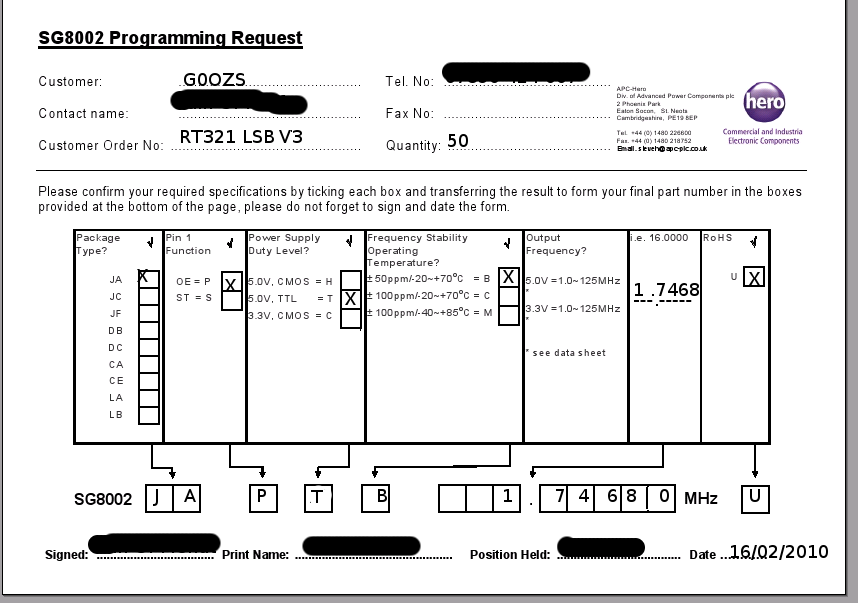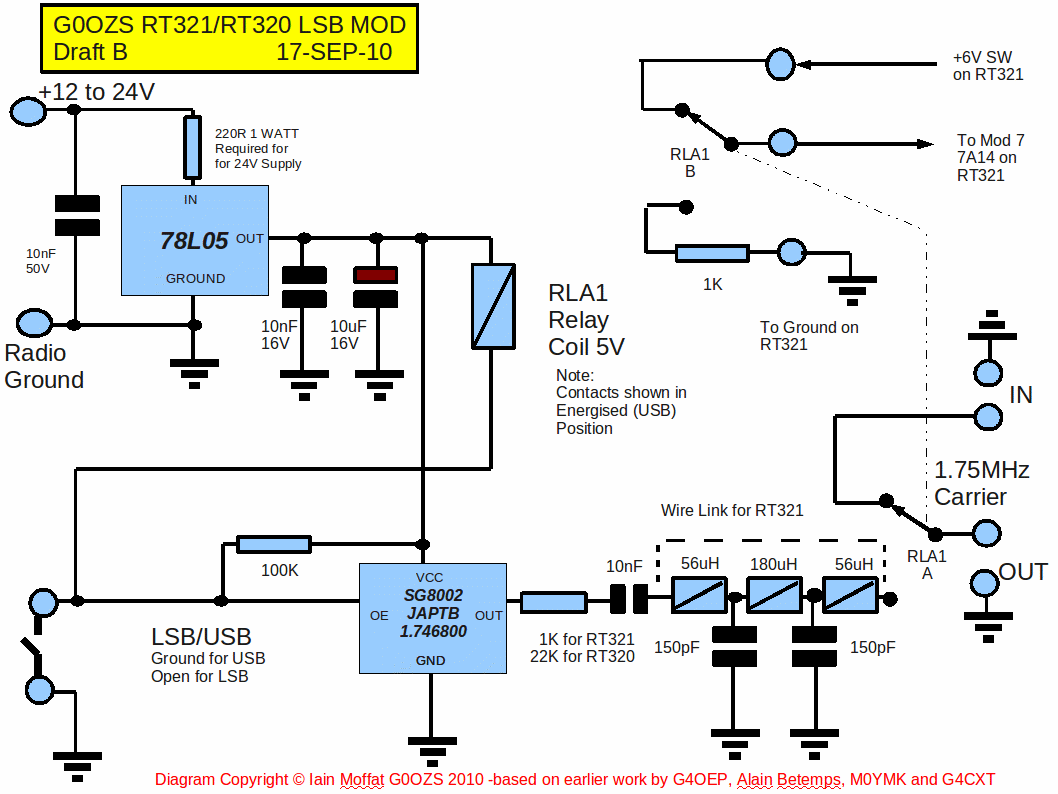LSB Conversion of RT321 and RT320 HF Sets
Introduction
The RT320 and RT321 Clansman HF sets are designed for Upper Side Band (USB)
operation only. This conflicts with the Amateur radio convention which is to
use LSB on bands below 10MHz. In both radios the IF used for SSB generation
is 1.7500 MHz and there is a sideband inversion between the IF and the
antenna. So LSB at the IF comes out as USB and USB at the IF comes out as
LSB. The IF filter passband for SSB is roughly 0.2 to 3.0KHz below the
IF frequency so the 1.7500MHz carrier is blocked leaving pure LSB.
To get LSB at the output it would be necessary either to change the filter
to a USB one or to move the carrier below the filter passband. The latter
approach is what was first documented by Dr. Andrew Smith G4OEP in his
excellent article now available on the VMARS Manuals web site:
http://www.vmarsmanuals.co.uk/newsletter_articles/rt320lsb.pdf
A crystal at 3.2KHz below the original 1.7500MHz = 1.7468MHz is
needed for the G4OEP LSB modification.
Unfortunately the size and cost of a 1.7468MHz crystal is now somewhat
of a problem and other cheaper solutions have been sought. One is to
use a programmable oscillator comprising a VHF crystal and a PLL
to generate programmed arbitary frequencies. Such an oscillator can
replace the transistor CIO in the G4OEP circuit provided a suitable
(5 V TTL) power supply is available and the output is adequately
filtered and at a level compatible with the radio.
The SG8002
A suitable oscillator is the SG8002-JAPTB which covers 1 to 125MHz
and has a 0 to 70 degrees C tolerance of 50ppm (so would be up to
87.5Hz off - not a problem for SSB but would affect narrow data
modes). At room temperature samples have measured within 5ppm of
the programmed frequency. Physically it is a J-Leaded plastic
package about the size of an 8 pin DIP op-amp. The data sheet is at
http://www.eea.epson.com/portal/pls/portal/docs/1/1567558.PDF
The programming details are as follows:

The pinout is:
| Output Enable (Active High) | Pin 1 |
| Ground | Pin 2 |
| Output | Pin 3 |
| Supply +5V | Pin 4 |
Important Note:
The Output Enable is active high - I misread the data sheet when
preparing the original suggested
circuit diagram. This has been pointed out by G4CXT and John Moore.
Last time I bought some they were £1.36 each for 50, with a programming
charge of £25 and carriage of £10 making an effective price of
£2.06 plus postage for programmed units.
I still have some left - please inquire at (my casllsign) @btconnect.com
if interested.
Modification details
I should prefix this section by stating that I have not personally
modified any sets (on the basis that mine aint broke so I will wait
til I really need LSB or have need to open them for repairs). I have
coordinated a bulk purchase of SG8002s and several people have had
success with the conversion on both RT320 and RT321. Critical factors
for success are to inhibit the 1.7500MHz built in CIO when using LSB
or have a changeover relay with good isolation (otherwise it appears
as a 3.2KHz tone on the transmitted LSB signal) and to set the
output level of the 1.7468MHz signal to match the original 1.75MHz
carrier.
RT320
The RT320 modification is as described by G4OEP except that the
1.7468MHz transistor CIO is replaced by the SG8002. A small 5V
voltage regulator is required which should be fed from the 12V
supply, since no 5V logic supply exists in this set. The 5V TTL
output of the SG8002 must be filtered to get a sine wave output.
A suitable filter design is:
R1 1K series
L1 56uH series
C1 150pF shunt
L2 180uH series
C2 150pF shunt
L3 56uH series
(This diagram needs a monospaced font like courier)
o--10nF---R1----L1-----L2-----L3-----o
| |
From SG8002 C1 C2 To Mixer
| |
o------------------------------------o
A possible circuit diagram for the oscillator is:

(Click to view full size version)
Switching LSB and USB
Various switching strategies have been used including
- The use of one headphone output as described by G4OEP
- Use of the batt check or freq check front panel switch positions
- Use of a reed switch inside the 320 case operated by an external magnet
RT321
The RT321 1.75MHz CIO appears on SMB socket 7SK1 at the bottom of
module 7 (1st LO) and suitable power and control signals also exist
on pins of this module. The circuit internally to module 7 is a
TTL output with 10nF and 1K in series so the same components in
series with the SG8002 output should be satisfactory.
The other relevant pins on module 7 are:
| 5V | 7a pin 8 |
| 0V | 7a pin 1 |
| CIO ENABLE +6V | 7a pin 14 |
| 1.7500MHz CIO out | 7SK1 |
As with the RT320 a number of switching approaches are possible
including
- A push or toggle switch in the Elapsed Time Indicator position
on the front panel
- Decoding the frequency switch inputs to module 7 to select LSB
for 3 and 7MHz - these are on 7a pins 16, 15, 24, 23, 21 and 22
in order. I dont have a decode for these to MHz so further
investigation is needed.
- Use of the left or right headphone output on one audio socket
- Use of harness or control socket pins for an external switch
Acknowledgements
This page is based on earlier work by Terry G4BFS, Alain Betemps, Mike Hyers,
Colin Guy, Iain M0YMK, Andy G4JAC, John Moore, G4CXT and others -
apologies if anyone feels I should have credited them.
Copyright ©2010 Iain Moffat G0OZS
Last Updated 05-Oct-2010

